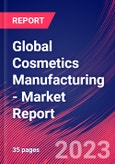Global cosmetic manufacturers faced troubles during the period. This industry provides a wide array of products; a good deal of these products are non-discretionary, which partly shielded manufacturers from major disruptions seen in 2020 during COVID-19. However, product lines like fragrances, parts of skincare and makeup are fully discretionary. As the disruptions ran their course, consumers spent less and remained at home to stop the spread of the virus. Because of this, demand for discretionary products plummeted, leaving a huge glut in demand within the market. In more recent years, a return of consumer spending and disposable income has led to heightened demand for discretionary products again; this growth led to a recovery in 2021. The end of the period is plagued with rapid inflation, present across several of the major countries involved in the industry, namely the US, UK and all of Europe. To fight inflationary pressure, the respective central banks of these countries have raised interest rates to slow the economies. As a result, consumers have scaled back spending as disposable income fell and consumer confidence dropped, further harming revenue. Thus, global cosmetics manufacturing revenue is expected to hover at a CAGR of 0.0%, around $450.9 billion through the end of 2023, even with a 1.3% drop, when profit is expected to grow to 2.3%.
The Global Cosmetics Manufacturing industry prepares, blends, compounds and packages toilet preparations and personal care products, including perfumes and fragrances, hair care, makeup, oral care, personal hygiene and skincare products. Operators in this industry are large multinational organizations that operate across the globe. Industry products are predominantly sold in downstream grocery, mass merchandisers and specialty retail stores.
This report covers the scope, size, disposition and growth of the industry including the key sensitivities and success factors. Also included are five year industry forecasts, growth rates and an analysis of the industry's key players and their market shares.
Table of Contents
Companies Mentioned (Partial List)
A selection of companies mentioned in this report includes, but is not limited to:
- Unilever
- L'Oreal SA
Methodology

LOADING...








